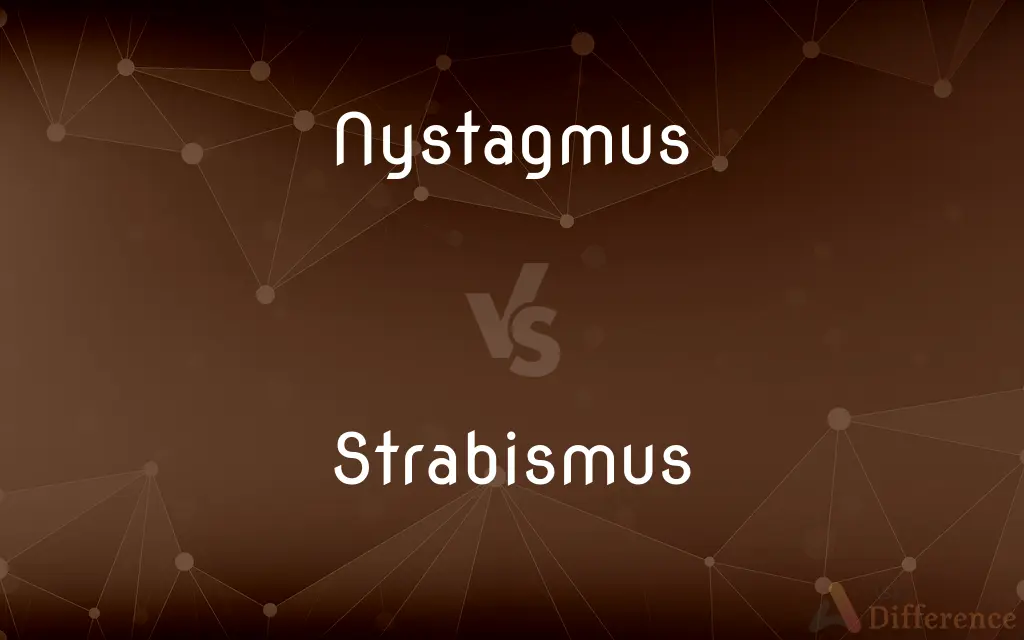Nystagmus vs. Strabismus — What's the Difference?
Edited by Tayyaba Rehman — By Fiza Rafique — Updated on April 16, 2024
Nystagmus involves involuntary eye movement, often appearing as shaking or wobbling eyes, whereas strabismus refers to misalignment of the eyes, commonly known as crossed eyes.

Difference Between Nystagmus and Strabismus
Table of Contents
ADVERTISEMENT
Key Differences
Nystagmus is characterized by rapid, involuntary movements of the eyes, which can be horizontal, vertical, or rotary. On the other hand, strabismus involves a lack of coordination between the eye muscles, causing the eyes to point in different directions.
The causes of nystagmus are varied, including genetic conditions, neurological disorders, or as a symptom of other eye issues. Strabismus, however, may result from muscle dysfunction, nerve damage, or congenital problems affecting the muscles around the eyes.
In terms of diagnosis, nystagmus can often be observed directly due to the visible wobbling or shaking of the eyes. Strabismus is usually identified through tests that evaluate eye alignment and coordination, such as cover tests and viewing tests.
Treatment for nystagmus often focuses on managing the underlying cause and may include glasses with prisms or even surgery, depending on severity and type. Strabismus treatment might involve corrective glasses, eye muscle exercises, or surgery to realign the eye muscles.
The implications for visual development and function differ significantly between these conditions. Nystagmus typically leads to reduced visual acuity, which cannot be corrected fully with glasses. Strabismus, if untreated, can lead to amblyopia (lazy eye), where the brain begins to ignore signals from the misaligned eye.
ADVERTISEMENT
Comparison Chart
Description
Involuntary eye movement (shaking, wobbling)
Misalignment of the eyes (crossed eyes)
Causes
Genetic, neurological, or as part of other conditions
Muscle dysfunction, nerve damage, congenital issues
Diagnostic Tests
Observation of eye movement, medical imaging
Cover tests, alignment tests
Primary Treatments
Addressing underlying cause, possibly surgery
Corrective glasses, exercises, surgery
Visual Implications
Usually reduces visual acuity
Can lead to amblyopia if untreated
Compare with Definitions
Nystagmus
Nystagmus may be present at birth or develop later in life.
Infantile nystagmus usually appears within the first few months of life.
Strabismus
Strabismus is a visual disorder where the eyes do not align properly under normal conditions.
Strabismus in her right eye causes it to drift outward.
Nystagmus
Nystagmus is a condition characterized by involuntary, rapid movement of the eyes.
Her nystagmus becomes noticeable when she looks to the side.
Strabismus
Early intervention is crucial to prevent long-term visual complications like amblyopia.
Strabismus treatment started early can prevent the development of a lazy eye.
Nystagmus
It can be classified as either "pendular" or "jerk," depending on the movement pattern.
Pendular nystagmus involves equal speed in both directions, whereas jerk nystagmus has a slow phase and a fast phase.
Strabismus
Treatment often involves wearing corrective glasses or undergoing eye muscle surgery.
He underwent surgery to correct his severe exotropia.
Nystagmus
Various treatments are employed to manage nystagmus, focusing on enhancing visual function.
Special lenses with prisms may be prescribed to help with nystagmus.
Strabismus
It can manifest as either esotropia (eyes turn inward) or exotropia (eyes turn outward).
Esotropia is commonly referred to as cross-eyed.
Nystagmus
The condition can worsen with stress or fatigue.
His nystagmus intensifies after long periods of reading.
Strabismus
Exercises like patching are sometimes used to strengthen the weaker eye in strabismus patients.
Patching the stronger eye forces the weaker eye to work harder and align properly.
Nystagmus
Nystagmus is a condition of involuntary (or voluntary, in some cases) eye movement. Infants can be born with it but more commonly acquire it in infancy or later in life.
Strabismus
Strabismus is a condition in which the eyes do not properly align with each other when looking at an object. The eye that is focused on an object can alternate.
Nystagmus
A rapid, involuntary, oscillatory motion of the eyeball.
Strabismus
A visual defect in which one eye cannot focus with the other on an object because of imbalance of the eye muscles. Also called squint.
Nystagmus
(pathology) rapid involuntary eye movement, usually lateral
Strabismus
A defect of vision in which one eye cannot focus with the other on an object because of imbalance of the eye muscles; a squint.
Nystagmus
A rapid involuntary oscillation of the eyeballs.
Strabismus
An affection of one or both eyes, in which the optic axes can not be directed to the same object, - a defect due either to undue contraction or to undue relaxation of one or more of the muscles which move the eyeball; squinting; cross-eye.
Nystagmus
Involuntary movements of the eyeballs; the presence or absence of nystagmus is used to diagnose a variety of neurological and visual disorders
Strabismus
Abnormal alignment of one or both eyes
Common Curiosities
Is surgery always required for strabismus?
Not always; options like glasses or specialized exercises may be effective, depending on the severity and type of strabismus.
What are common symptoms of nystagmus?
Common symptoms include uncontrolled eye movement and difficulties with seeing clearly.
How is strabismus diagnosed?
Strabismus is diagnosed through physical examination and specific eye alignment tests by an eye care professional.
What are the potential effects of untreated strabismus?
Untreated strabismus can lead to amblyopia (lazy eye), where the brain ignores visual input from the misaligned eye.
Can nystagmus go away on its own?
Nystagmus generally does not resolve on its own and requires management of the underlying cause or condition.
Can strabismus lead to other health issues?
Yes, it can lead to psychological impacts due to appearance concerns and social stigma, in addition to amblyopia.
Can adults develop nystagmus?
Yes, adults can develop nystagmus due to various causes, including injury or neurological conditions.
How does nystagmus affect daily activities?
Nystagmus can impact tasks that require stable vision, such as reading and driving.
Are there any preventative measures for strabismus?
Early detection and treatment in children can prevent long-term effects, but many cases, being congenital, cannot be prevented.
What types of healthcare providers treat strabismus?
Ophthalmologists, particularly pediatric ophthalmologists, and orthoptists typically treat strabismus.
What are the challenges in diagnosing nystagmus?
Diagnosing the underlying cause of nystagmus can be complex and may require multiple types of tests.
What are the different types of nystagmus?
Key types include infantile, acquired, pendular, and jerk nystagmus.
Is there a genetic component to strabismus?
Yes, genetics can play a role, particularly in congenital forms of the condition.
How can nystagmus be managed in children?
Management often includes corrective lenses, surgery, or other treatments aimed at improving visual function.
How effective are non-surgical treatments for strabismus?
Non-surgical treatments like vision therapy and corrective lenses can be very effective, especially in mild cases.
Share Your Discovery

Previous Comparison
Enhancement vs. Enrichment
Next Comparison
Potable vs. PottableAuthor Spotlight
Written by
Fiza RafiqueFiza Rafique is a skilled content writer at AskDifference.com, where she meticulously refines and enhances written pieces. Drawing from her vast editorial expertise, Fiza ensures clarity, accuracy, and precision in every article. Passionate about language, she continually seeks to elevate the quality of content for readers worldwide.
Edited by
Tayyaba RehmanTayyaba Rehman is a distinguished writer, currently serving as a primary contributor to askdifference.com. As a researcher in semantics and etymology, Tayyaba's passion for the complexity of languages and their distinctions has found a perfect home on the platform. Tayyaba delves into the intricacies of language, distinguishing between commonly confused words and phrases, thereby providing clarity for readers worldwide.














































